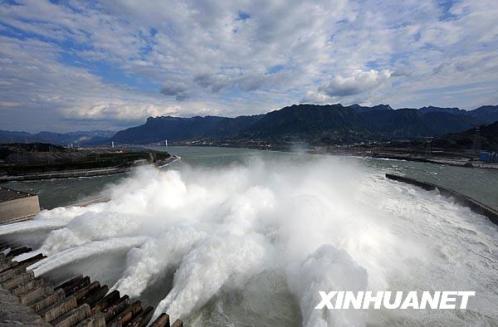The Three Gorges hydropower project will be completed this year; hence the proceeds, including revenues from taxes and other fees are due for apportionment. In the recent annual NPC (National People's Congress) and CPPCC (China People's Political Consultative Conference) sessions, Chongqing Municipality and Hubei Province, the two administrative regions that are primarily concerned, stepped up their intensive lobbying campaigns to gain a bigger share in the new round of revenue distribution. It has been reported that the Three Gorges facility will generate annual tax revenues of more than 5 billion yuan (US$7.32 billion).
 |
| Revenues disputes over Three Gorges Project [Xinhua] |
During the sessions, Chongqing's municipal government organized a press conference presenting arrangements for the project's reservoir area, in the course of which Vice Mayor Tan Xiwei said that the resettlement of the reservoir area had been concluded but that the economic situation of the area remained weak. He also set out an expectation of more assistance from central revenues to help this area, whose economy lags well behind the country's average.
In the meantime, Hubei claims that current plans for revenue distribution do not comply with taxation principles, and it expects a fairer proportion of the project's revenues once fully completed.
The Three Gorges hydropower power site consists of the reservoir area and the dam area. The flooded areas for resettlement are mainly in Chongqing, but the dam and the hydropower station are in Hubei. It has therefore proved difficult to satisfy both sides in the distribution of revenues.
The Ministry of Finance is reported to put forward this year a series of proposals concerning industrial funds and allocation of revenues, in order to balance the interests of both Chongqing and Hubei in the allocation of revenues once the dam cranks up into full scale operation.
The Three Gorge Reservoir Area Industrial Fund, in which central revenue invested 5 billion yuan (US$7.32 billion) to support industrial projects in this region, is due to mature this year. According to Wu Zhenglong, Party chief of Wanzhou District, Chongqing, the central government will continue to finance the reservoir area's industry and the sum is expected to double from the current 1 billion yuan (US$146 million).
The Party chief is of the view that this fund should also be apportioned according to the flooded area – 84 percent to Chongqing and 16 percent to Hubei.
In addition to this fund, the allocation of tax revenue is another major bone of contention between the two regions. During the period of generator construction up to 2003, the infrastructure's tax revenues were chiefly managed by Hubei, and shared between the Central Revenues and local finance according to an agreed arrangement. From 2003 to 2009, the tax revenues were shared between the two regions according to the flooded area. However, with regard to the period after the project's completion in 2009, the Ministry of Finance has yet to announce a clear plan.
In essence, the tax revenues from the Three Gorge Project comprise all the taxes related to the hydropower station, principally income tax, VAT, and urban construction tax.
Before 2009, the entire income tax revenues of the project were submitted to China Three Gorges Project Corporation as the project's construction fund. As the project will be completed soon, the corporation will be dissolved; hence questions are being raised regarding the distribution of the station's revenue between Chongqing and Hubei.
As to the distribution of VAT and urban construction tax, an official from Hubei Provincial Department of Finance tells The Economic Observer that Hubei has contributed all the resources required for tax collection – manpower, material resource and financial costs, and furthermore, the power plant's operation and administration sites are both in Hubei, but in revenue allocation, Hubei only gets 1/6 of Chongqing's sum.
This year, Hubei provincial government has made several detailed reports to the central authorities, indicating that the total revenues from the period 2003-09 will amount to 25 billion yuan (US$3.6 billion). After deductions submitted to the corporation and central revenue, Hubei's share will be 367 million yuan (US$53.73 million) whereas Chongqing gets 1977 million (US289.56 million), almost 6 times the Hubei quota.
In response to Hubei's claim, Wanzhou's Party chief Wu Zhenglong thinks otherwise: albeit the dam area is where the electricity is generated, the hydraulic power is from the water resource stored in Chongqing. Therefore, the two areas should both be regarded as production sites, so that the two administrative regions are eligible for the project's earnings. In addition to insisting on a continuation of the current allocation structure, he also suggests that central revenue increases its assistance in developing the reservoir area.
In contrast, the official with Hubei's provincial department of finance indicates that Hubei did agree with the initial allocation plan, based on the area flooded, but this should apply only during the project's construction period, when issues like population resettlement were still in process. As the hydropower project completes, revenue allocation should follow new principles, and Hubei's share should increase.
Chongqing has even proposed a "water resource" fee in an attempt to protect the upper stream's water quality and ecology. Hence, hydraulic power plants are likely to be charged for the water resource they use. This proposal was welcomed by the State Council. "It would be ideal to start next year", the municipality suggests.
(China.org.cn by Maverick Chen, March 17, 2009)